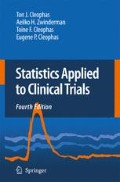Small precision of clinical trials is defined as a large spread in the data. Repeated observations have a central tendency, but also a tendency to depart from the central tendency. If the latter is large compared to the former, the data are imprecise. This means that p-values are large, and reliable predictions cannot be made. Often a Gaussian pattern is in the data. The central tendency can, then, be adequately described using mean values as point estimates. However, if the data can be fitted to a different pattern like a linear or a curvilinear pattern, the central tendency can also be described using the best fit lines or curves of the data instead of mean values. This method is called data modeling, and may under the right circumstances reduce the spread in the data and improve the precision of the trial. Extensive research on the impact of data modeling on the analysis of pharmacodynamic / pharmacokinetic data has been presented over the past 10 years. The underlying mechanism for improved precision was explained by the late Lewis Sheiner: “Modeling turns noise into signals”.1,2 In fact, instead of treating variability as an “error noise”, modeling uses the variability in the data as a signal explaining outcome. If regression models are used for such purpose, an additional advantage is the relative ease with which covariates can be included in the analysis. So far, data modeling has not been emphasized in the analysis of prospective randomized clinical trials, and special statistical techniques need to be applied including the transformation of parallel-group data into regression data. In the current chapter we demonstrate two regression models that can be used for such purpose. Both real and hypothesized examples are given.
Access this chapter
Tax calculation will be finalised at checkout
Purchases are for personal use only
Preview
Unable to display preview. Download preview PDF.
References
Sheiner LB, Steimer JL. Pharmacokinetic / pharmacodynamic modeling and drug development. Clin Pharmacol Ther 1984; 35: 733–41.
Fuseau E, Sheiner LB. Simultaneous modeling of pharmacokinetics and pharmacodynamics with a nonparametric pharmacodynamic model. Clin Pharmacol Ther 1984; 35: 733–41.
Cleophas TJ. The sense and non-sense of regression modeling for increasing precision of clinical trials. Clin Pharmacol Ther 2003; 74: 295–7.
Cleophas TJ. Problems in regression modeling of randomized clinical trials. Int J Clin Pharmacol Ther 2005; 43: 5–12.
Editor information
Editors and Affiliations
Rights and permissions
Copyright information
© 2009 Springer Science + Business Media B.V.
About this chapter
Cite this chapter
(2009). Regression Modeling for Improved Precision. In: Cleophas, T.J., Zwinderman, A.H., Cleophas, T.F., Cleophas, E.P. (eds) Statistics Applied to Clinical Trials. Springer, Dordrecht. https://doi.org/10.1007/978-1-4020-9523-8_17
Download citation
DOI: https://doi.org/10.1007/978-1-4020-9523-8_17
Publisher Name: Springer, Dordrecht
Print ISBN: 978-1-4020-9522-1
Online ISBN: 978-1-4020-9523-8
eBook Packages: Mathematics and StatisticsMathematics and Statistics (R0)

